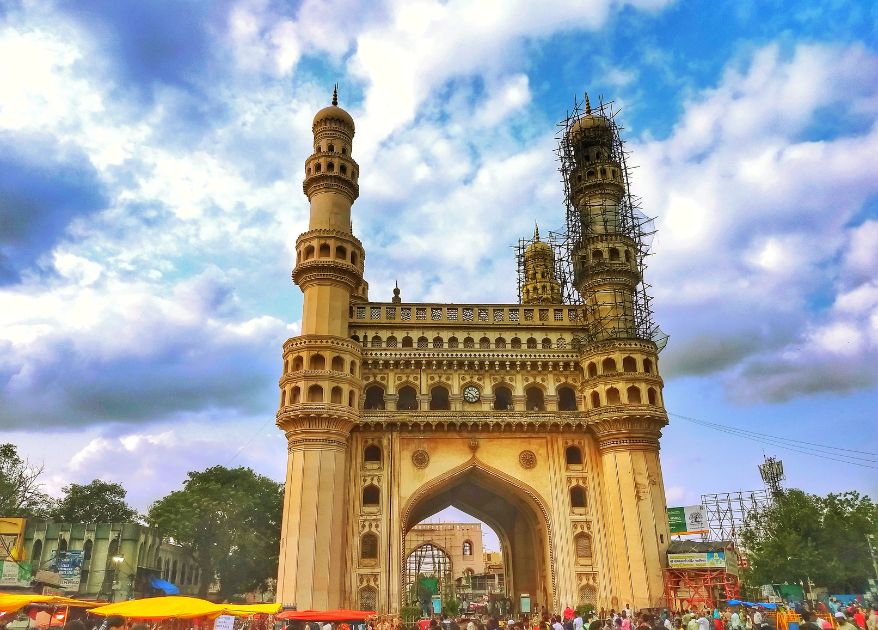BlogHistorical MonumentsThe Charminar: A Symbol of Hyd...
The Charminar: A Symbol of Hyderabad's Glory
The Magnificent Charminar, a prominent landmark situated in the heart of Hyderabad, stands as a testament to the city's rich history, architectural grandeur, and cultural heritage. This iconic monument has become a symbol of Hyderabad's glory and continues to captivate visitors from around the world. With its mesmerizing beauty and historical significance, the Charminar holds a special place in the hearts of locals and tourists alike.
Table of Contents
ToggleHistory and Origins
The Charminar was constructed in 1591 by Sultan Muhammad Quli Qutb Shah, the fifth ruler of the Qutb Shahi dynasty. Its name, Charminar, translates to "Four Minarets" in English, referring to the monument's four graceful minarets that soar skyward. The purpose of its construction was to commemorate the end of a deadly plague that devastated the city.
Architectural Significance
The Charminar showcases a magnificent blend of Indo-Islamic architecture, with influences from Persian, Indian, and Islamic styles. The structure stands at a height of 56 meters and features four towering minarets, each adorned with delicate ornamental balconies. The central structure consists of four arches, leading in different directions and forming four impressive grand entrances.
Cultural Significance
The Charminar is not only a remarkable architectural marvel but also an integral part of Hyderabad's cultural fabric. It serves as a symbol of the city's unity, diversity, and religious harmony. The monument is located in close proximity to several revered religious sites, including the Mecca Masjid, making it a sacred place for Muslims.
The Charminar Today
Today, the Charminar is not just a historical monument; it has transformed into a bustling hub of activity. Surrounding the monument, vibrant markets and bazaars thrive, attracting tourists and locals alike. The lively atmosphere, aromatic flavors, and intricate handicrafts make it an enchanting destination for shopping and exploration.
Exploring the Surrounding Bazaars
The Charminar is surrounded by charming bazaars that offer a unique shopping experience. Laad Bazaar, located adjacent to the monument, is renowned for its exquisite bangles, pearls, and traditional bridal attire. Additionally, Pather Gatti is a bustling market known for its vibrant textiles, silk sarees, and perfumes. These bazaars provide a glimpse into the rich culture and traditions of Hyderabad.
Festivals and Celebrations
The Charminar serves as a focal point for various festivals and celebrations in Hyderabad. During Eid al-Fitr and Eid al-Adha, the monument comes alive with colorful decorations, and the air is filled with festive cheer. The annual Bonalu festival, dedicated to the Hindu goddess Mahakali, witnesses a grand procession starting from the Charminar. These celebrations showcase the unity and diversity of Hyderabad's communities.
The Charminar and Nizami Cuisine
Hyderabad is renowned for its delectable Nizami cuisine, and the Charminar plays a significant role in promoting this culinary heritage. The area around the monument is dotted with iconic eateries that serve mouthwatering biryanis, haleem, and traditional sweets like qubani ka meetha and double ka meetha. A visit to the Charminar is incomplete without savoring these delectable culinary delights.
Impact on Tourism
The Charminar has emerged as a major tourist attraction, drawing visitors from all corners of the globe. Its architectural splendor, cultural significance, and vibrant surroundings make it a must-visit destination. The monument has played a crucial role in boosting tourism in Hyderabad, contributing to the city's economy and creating employment opportunities for the local population.
Preservation and Restoration Efforts
To ensure the preservation of this architectural marvel, various restoration projects have been undertaken over the years. The Archaeological Survey of India (ASI) and other organizations have been actively involved in maintaining and safeguarding the Charminar's structural integrity. These efforts aim to protect its historical legacy for future generations to appreciate and cherish.
Conclusion
The Charminar stands as an iconic symbol of Hyderabad's glory, captivating visitors with its architectural magnificence and cultural significance. Its rich history, vibrant surroundings, and delectable cuisine make it a treasure trove of experiences. A visit to this remarkable monument is a journey through time and an exploration of the city's vibrant heritage.
FAQs (Frequently Asked Questions)
No, It is open to the public without any fees or charges.
Yes, Visitors can explore the monument and enjoy the surrounding bazaars.
No, climbing the minarets is not permitted for the general public due to safety reasons.
While there are no specific restrictions, visitors are expected to respect the sanctity of the monument and adhere to the guidelines provided by the authorities.
Yes, guided tours are available for visitors who wish to learn more about the Symbol of Hyderabad. These tours provide valuable insights into the monument and its surrounding areas.
Yes, photography is allowed inside the Charminar. However, it is advisable to check with the authorities regarding any specific guidelines or restrictions.
The best time to visit the Charminar is during the early morning or late afternoon to avoid the crowds and enjoy the pleasant weather.
Efforts have been made to improve accessibility at the Charminar. However, due to the historical nature of the monument, there may still be certain limitations. It is advisable to check with the authorities for specific accessibility information.
It is located in the old city area of Hyderabad and is well-connected by various modes of transportation. Visitors can reach the monument by taxi, auto-rickshaw, or public transportation.
Yes, there are several attractions near the monuent, including the Mecca Masjid, Chowmahalla Palace, and the Salar Jung Museum.


Add a Comment